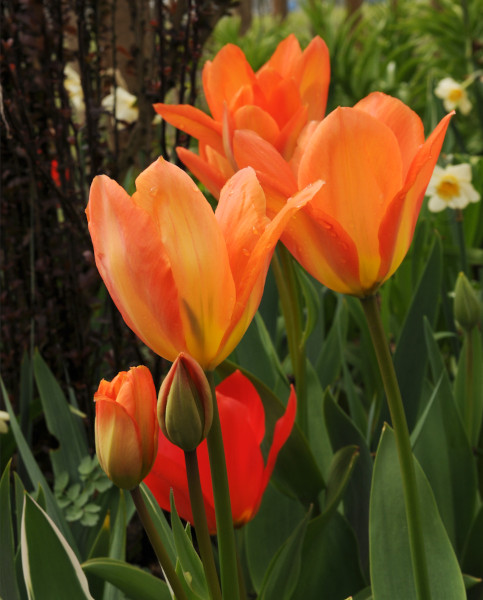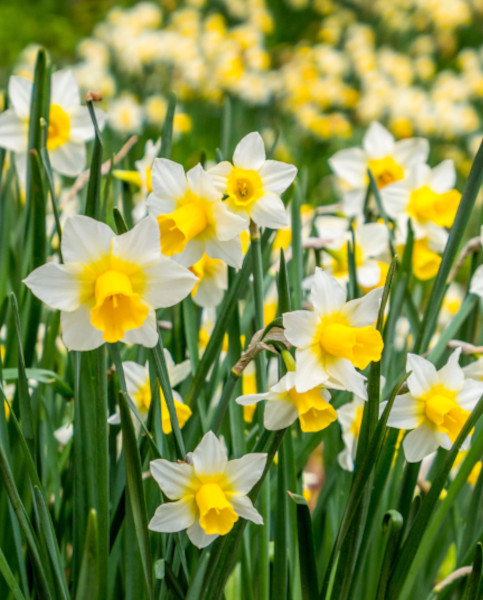How to grow Tulips
From voluptuous doubles and elegant lily-flowering cultivars, to incredible multicoloured parrots which look as though they belong in a Dutch Masters painting, Tulips are the epitome of spring.
Available in early and late varieties, Tulips bloom throughout spring and bring a welcome splash of colour to garden borders and pots. Growing several varieties in a mix of shapes and shades which flower at slightly different times will really extend the season of interest for you.
Some varieties such as Tulip clusiana Chrysantha, which is a Species Tulip, naturalise and self-seed in grassy areas, returning year after year without fail.
New and unusual Tulip varieties are constantly being bred and choosing and purchasing your bulbs well before you plan to plant them is always recommended to ensure you have the pick of the bunch. Your bulbs will be dispatched when it is time for planting in autumn.
Tulips make wonderful, long-lasting cut flowers and continue to elongate even after cutting - you may find yourself trimming the ends as you refresh the water every couple of days. Our new Hayloft Tulip collections have been specially selected to bring together complimentary combinations of Tulips which look fabulous both in the garden, and in the vase.

Key Information
Soil pH
Position
Hardiness


Where & when to plant Tulips
Tulip bulbs should be planted in late autumn, we recommend November when the ground is cooling down which will help to prevent Tulip fire (a fungal disease which thrives in warm soil). Tulips can be planted as late as January, but the resulting blooms may not be as large, and the stems are likely to be shorter.
Tulips are perennials, but many gardeners, especially those who grow Tulips for cutting, grow them as annuals, pulling up and composting the bulbs as they pick the blooms. This is because the largest and healthiest blooms are produced in the first year. With some general care and feeding, Tulips will return every spring and will be worth the wait.
Tulips thrive in all soil types and pH levels. Although they prefer to grow in a sunny spot, most varieties will tolerate some shade, particularly the paler coloured Tulips.
How to plant Tulips
When you have chosen the perfect location for your bulbs, dig some organic matter such as well-rotted manure, bonemeal, or chicken manure pellets into the ground as Tulips like to grow in fertile soil which will help them to perennialise. Introduce some horticultural grit or pea shingle to the bottom of planting holes or beds too, particularly if you garden on clay soil.
A great tool for planting bulbs with ease is a bulb planter which removes a core of soil, leaving behind a perfect planting hole which you can pop your bulb into, followed by the plug of soil on top. Or you can dig individual holes with a garden trowel or spade for planting into. Place your bulbs pointy-end up, 5-10cm apart, ideally in groups or clumps for a natural effect rather than dotting them around the garden. Replace the layer of soil on top before firming down gently to remove any air pockets.
For pot-grown Tulips, use a peat-free multipurpose compost with some added grit for drainage and choose a large, deep pot or planter.
If you are growing a large number of Tulips for cutting, you can dig out a trench, or strip of ground and add a layer of grit before laying your bulbs on top and backfilling with soil in the same way. The bulbs can be grown closely together, almost (but not quite) touching if you plan to pull them up after flowering.
Tulip bulbs should be planted at a depth at least 3 times the height of the bulb. A deeper planting will ensure repeat blooming in future years, help prevent disease, and will make the bulbs harder to find by hungry squirrels!
Water your bulbs in well after planting and unless you are growing them in a pot, they will not require further watering.

What to plant with Tulips
At Hayloft, we have an extensive and ever-growing range of Tulips available, and we have put together some great combinations for you to try.
Tulips can add a blast of colour, timeless elegance, or drama to your garden, and some varieties are sweetly scented such as the beautiful orange-bronze Tulip Brown Sugar.
Try pairing dark and mysterious tulips like double Tulip Peony Black Hero or Tulip Triumph Ronaldo with pure white Tulip Purissima or statuesque Tulip Apricot Beauty. Add in other spring flowering bulbs such soft Narcissus Bell Song, Fritillarias and low growing Heucheras for a striking and unusual display.
Create a welcoming corner of your garden or patio with a set of pots and containers in varying heights full of tulips and other spring bulbs. Whether you love bright colours, pastels, or a simple white and green planting scheme, there will be a range of Tulips which are perfect.
Please contact our helpful and knowledgeable Customer Care Team at Hayloft if you would like any planting ideas or further advice for your Tulips, we will be happy to help.



How to care for Tulips
Only Tulip bulbs grown in pots where the compost will dry out quickly need regular watering, unless during prolonged periods of drought.
From the second year onwards, when the tips of Tulips begin to emerge in early spring, feed the soil with a high potash feed such as homemade comfrey feed, tomato feed, or a balanced seaweed liquid fertiliser.
If you cut some of your Tulip stems to bring into the home, make sure you leave at least one or two sets of leaves attached to the bulb to allow the plant to photosynthesise and repeat flower the following year. Deadhead any spent blooms after flowering, again leaving behind at least a pair of leaves to fade and dry naturally.
In early summer, you can remove the faded foliage and perhaps overplant the ground with annuals for colour or groundcover.
A mulch of homemade or spent compost in Autumn will keep the soil and your bulbs healthy and will help to keep weeds at bay.
Some gardeners choose to lift, divide, and store Tulip bulbs after flowering but most leave the bulbs in the ground. There are no major benefits to lifting for summer and offsets take several years to flower. For this reason, most gardeners buy new bulbs rather than attempting to propagate Tulips.
How to propagate Tulips
Tulips can be propagated in two ways but the usual way is by the bulblets which sprout from the mother bulb under the surface of the soil.
Lift the bulbs by digging with a trowel or a spade, brush off the soil from them, then gently break off the offset bulblets which are attached to the main bulb. Replant both the offsets and the main bulbs at a depth of around 3 times the bulbs diameter, with the pointed end upwards.
Tulips can also be propagated by seed but this is quite uncommon as they are really slow to get going and the seeds collected from hybrid plants do not generally produce the same flowers are the original plant. Specia tulips can come true but the seeds can take up to two years to mature.




